| dc.contributor.advisor | Beevers, Leonard, | en_US |
| dc.contributor.author | Butler, Juliet Marie. | en_US |
| dc.date.accessioned | 2013-08-16T12:29:57Z | |
| dc.date.available | 2013-08-16T12:29:57Z | |
| dc.date.issued | 1998 | en_US |
| dc.identifier.uri | https://hdl.handle.net/11244/5595 | |
| dc.description.abstract | Procedures have been developed for the dissociation of coat proteins from clathrin-coated vesicles isolated from cotyledons of developing pea, Pisum sativum L. Based on molecular sizing chromatography, immunoreactivity, subunit composition and interaction with both clathrin and vacuolar targeting receptors we have identified adaptor protein complexes among the dissociated proteins. These adaptor proteins exist as large globular complexes of similar molecular mass and subunit composition to those of mammals. A single 110kD subunit is immunologically related to the $\beta$-adaptins of bovine brain. Candidates for $\alpha/\gamma$ subunits are also present. In addition to the large subunit homologs, two $\mu$-adaptin candidates of 47 and 50kD bind to an affinity matrix coupled to antibodies against the mammalian $\beta1/\beta2$ adaptins, providing evidence for two adaptor complexes in plants. Pea cotyledon clathrin readily self-assembles into polyhedric coats upon dialysis under assembly conditions. Clathrin and calcium concentrations and pH have similar effects on cage assembly of both plant and brain clathrin. Under physiological conditions, pea cotyledon clathrin-adaptor proteins are incorporated into and affect both the diameter and size distribution of coats formed in their presence, but are not required for assembly. Adaptor proteins from bovine brain markedly stimulated assembly of pea clathrin into hybrid coats intermediate in size between those of brain and pea cotyledon. Both the brain adaptors were incorporated into these structures. In contrast, no stimulation of assembly was observed when pea cotyledon adaptors were dialyzed with brain clathrin under assembly conditions. Evidence of an "adaptor" function is provided by the binding of purified pea cotyledon adaptors to a transmembrane vacuolar targeting receptor, BP-80, present in clathrin-coated vesicles and a less-dense membrane fraction. In similarity to a number of mammalian transmembrane receptors, the cytoplasmic tail of BP-80 contains a canonical tyrosine-sorting motif of the form YXXO Component polypeptides of adaptors from pea cotyledon-, wheat germ- and bovine brain-coated vesicles bind specifically to an immobilized peptide corresponding to the entire cytoplasmic domain of the Arabidopsis homolog of BP-80, and to a trucated peptide containing the tyrosine motif, suggesting a universality in the mechanisms of protein sorting and targeting in the endomembrane systems of plants and animals. | en_US |
| dc.format.extent | ix, 184 leaves : | en_US |
| dc.subject | Plant proteins Physiological transport. | en_US |
| dc.subject | Coated vesicles. | en_US |
| dc.subject | Peas. | en_US |
| dc.subject | Biology, Botany. | en_US |
| dc.subject | Biology, Plant Physiology. | en_US |
| dc.subject | Biology, Cell. | en_US |
| dc.title | Characterization of clathrin adaptor proteins from cotyledons of developing pea (Pisum sativum L.). | en_US |
| dc.type | Thesis | en_US |
| dc.thesis.degree | Ph.D. | en_US |
| dc.thesis.degreeDiscipline | Department of Microbiology and Plant Biology | en_US |
| dc.note | Source: Dissertation Abstracts International, Volume: 59-01, Section: B, page: 0027. | en_US |
| dc.note | Adviser: Leonard Beevers. | en_US |
| ou.identifier | (UMI)AAI9822811 | en_US |
| ou.group | College of Arts and Sciences::Department of Microbiology and Plant Biology | |
